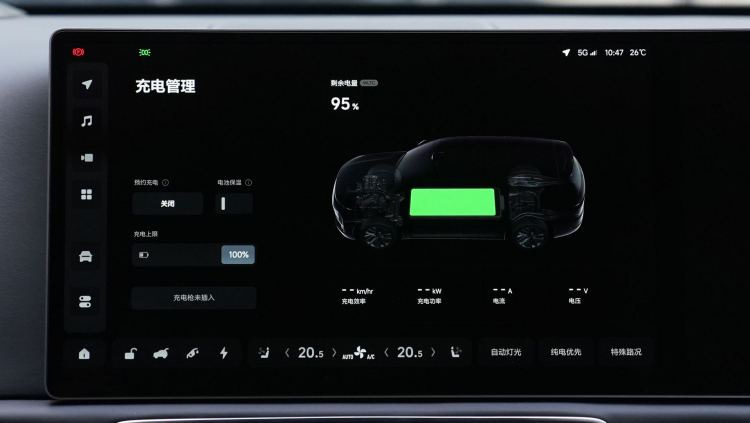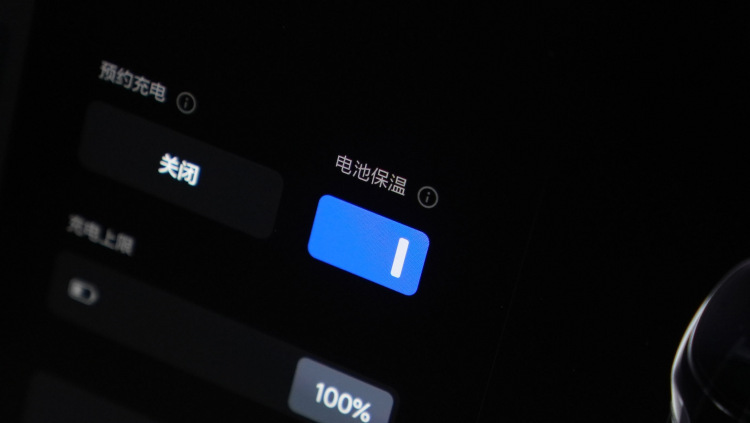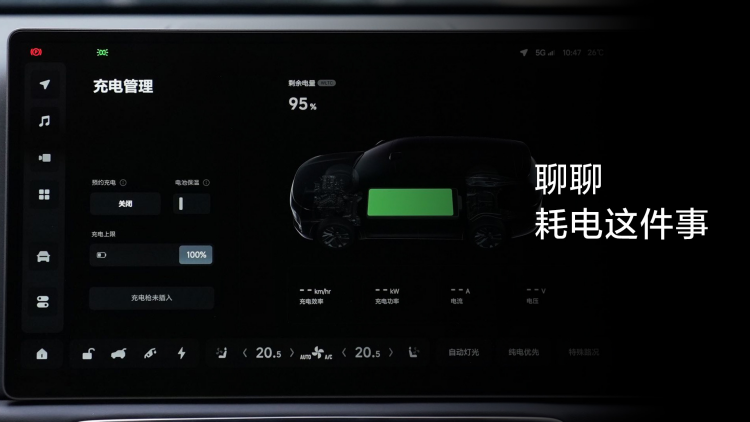For many car enthusiasts, the ideal car may be the first smart electric car they buy. Whether it’s out of curiosity or novelty, they are very sensitive to battery consumption.
I frequently receive questions from the community, such as how can the battery lose 4% in one night? How can the battery lose 20% but only drive 20 kilometers? For electric car owners who have experienced all four seasons, the answers to these questions may not be surprising. However, for newbies, they are still full of doubts. Today, let’s use the Ideal L9 as an example to discuss power consumption.
In cold weather, batteries also need to stay warm
Spring is the best season for electric cars to run with the best range. The temperature around 20℃ allows the battery to maintain its optimal working temperature range. Winter, on the other hand, is the time when the range of electric cars is least friendly.

As the temperature gradually drops below 15℃, 10℃, 5℃… your power consumption will increase because the energy needed to maintain the battery temperature also comes from the battery. This part of the heat is converted from electricity in the battery, and “frozen batteries” can lead to decreased power and increased energy consumption, which is determined by the physical characteristics of the battery.
Therefore, the power consumption of any electric car will increase in winter. Range-extended electric cars consume less power than pure electric cars in high-speed road conditions because the range extender will satisfy the vehicle’s demand for heat through waste heat, such as battery temperature, heating and air conditioning. Pure electric cars don’t have this condition (which is why range-extended electric cars sell well in the northeast region). Generally, waste heat is mainly used during the range extender’s steady-state range, and it’s difficult to use it when driving in a city with frequent starts and stops.

It should be noted that when a range-extended electric car is driving in pure electric mode, its winter performance is no different from that of a pure electric car. At the same time, if you have a home charging pile, you can turn on the “battery warming” function. After a slow charge is completed, a small current will maintain the battery temperature (the process of charging will consume a certain amount of electricity), reducing winter mileage loss. Generally, if the parking environment is below 15℃, you can turn on the battery warming function, which is mainly suitable for parked cars outdoors.If everyone has a fixed commute time every day, the “scheduled charging” function can also achieve the effect of battery warmth. Assume you leave home at 8 am, and you can set the scheduled charging at 2 am, so the battery will be fully charged in about six hours and it will still be warm.
Heated air-conditioning is a true power consumer
In addition to the battery itself requiring heat preservation in low-temperature weather, our passengers also need heat preservation, so heated air-conditioning appears. Whether it’s the Ideal One, L9, or L8, they all use PTC heaters as the heat source for air conditioning. The advantage of PTC heaters is that they heat up very quickly and reach a comfortable temperature for passengers in the shortest time, but the disadvantage is that they consume a lot of electricity.
The power range of the Ideal L9 air conditioning compressor (responsible for cooling) is 300W~5500W. There are two PTC heaters, one front and one rear. The power range of the front one is 900W~7700W, and the power range of the rear one is 200W~3500W. That is to say, if you turn on the front and rear heated air conditioning of the vehicle in extremely cold weather, the theoretical peak power consumption may reach 11 kW. This peak condition requires about 10 kWh of electricity consumption in one hour of operation, which means you need to drive 50 kilometers less in pure electric mode. Now you know where your power goes, right? As for why PTC heaters with high power are chosen, it is mainly to heat up quickly. It is particularly important to heat up quickly when the outside temperature is low.
Generally speaking, PTC heaters do not continue to operate at maximum power to heat. Based on my daily experience, it is normal to drive 20-30 kilometers less in pure electric priority mode after opening the heated air conditioning for one hour. The energy consumption for heating is almost four to five times that of cooling. By comparison, the power of heated steering wheels and heated seats is much lower. Car friends who are concerned about energy consumption can use heated steering wheels and heated seats more.
Someone may also ask, my home has a larger area and the air conditioning power used there is not as high as that of a car. In fact, this is the case because the airtightness and air flow inside the car cannot be compared with that of a home, so the power required for cooling and heating of a car is not small.
In highway or steady-state cruising scenarios, the waste heat generated by the range extender will replace the PTC heater, which can save electricity consumption well.### Short Commutes, High Energy Consumption
Stop-and-go traffic, whether for gasoline or electric vehicles, is not friendly because the frequent starting and stopping means that energy consumption cannot be reduced. Currently, my round trip commute is only 5 kilometers, but the energy consumption is still around 25 degrees, which is similar to when I drove a 2.0T Golf for commuting, which consumed about 12 gallons of gasoline. As you can imagine, short commutes have a significant impact on energy consumption.
Does the Refrigerator Consume a Lot of Electricity? NO, the Root Cause is Elsewhere
The refrigerator on the Ideanomics L9 is actually a configuration that everyone loves, and it doesn’t consume a lot of electricity itself. If it continuously works for 24 hours, the power consumption of the refrigerator itself is about 0.5 kWh, which means that the electricity consumption is very low when it’s running while driving.
However, it should be noted that those who have provided feedback that the refrigerator consumes a lot of electricity have all opened the “Refrigerator Continuously Runs for X Hours After Leaving the Car” function. In this case, more energy is consumed. I tried it out and found that it consumed about 13% of the electricity in 24 hours, but most of it was not consumed by the refrigerator.
When this function is not turned on, the vehicle will enter hibernation mode after a person leaves the car, and the power consumption is very low. However, because you need the refrigerator to run after you leave the car, the entire vehicle needs to maintain a high-voltage power supply status, which means that the high-voltage safety monitoring also needs to remain operational. The operation of these controllers will cause an increase in energy consumption. During normal driving, these controllers are shared, so the additional energy consumption is not noticeable. But after the vehicle is turned off, these controllers become dedicated for the refrigerator, so it feels like the refrigerator is consuming more electricity, but it’s not actually the case.
In fact, the function of keeping the refrigerator running after leaving the car can bring us a lot of convenience. For example, after a two-hour hiking trip, there is still cold drinks to enjoy. As long as everyone uses this function reasonably and has a psychological expectation of its energy consumption, we can enjoy the happiness brought by this function.
Enjoying Intelligent Space Also Requires Electricity Support
More and more car owners like to stay in their cars for a while, watch movies, listen to music, or take a rest. During this process, whether it’s for watching movies, listening to music or resting, the vehicle needs to maintain a continuous power supply. If you also turn on the air conditioning, even if the vehicle doesn’t move, it will still consume electricity. I once tried it for an hour with the air conditioning’s refrigeration function on, and it consumed about 2% of the electricity. If the heating function of the air conditioning is turned on, this number will be even higher.However, with such low electricity fees, why not spend a few bucks to enjoy a few hours of comfort?
Full Charge Driving vs. Energy Recovery
A car owner asked me why the power consumption increases right after the car is fully charged. The reason is related to energy recovery. The battery can only recover energy if there is space left, and when it is fully charged, there is no room left for energy recovery. Observing power consumption when the car’s battery is about 90% charged will result in a more familiar feeling.
OTA Upgrades also Consume Electricity
The much-anticipated OTA upgrade also consumes a certain amount of electricity. If you’ve scheduled an upgrade overnight and find that your battery is about 4% lower the next morning, don’t panic. It’s just your car consuming electricity during the upgrade process.
Remote Connections Consume Energy
Every time you remotely connect to your vehicle via the “Remote Control” page on your phone to view various statuses, you will consume some electricity. This is a normal operation. Reducing unnecessary remote connections can save energy.
Aggressive Driving vs. an Ideal Driving Style
Lastly, let’s talk about how driving habits affect power usage. Aggressive driving undoubtedly increases power consumption, especially if you repeatedly step on the accelerator and brake pedal. If you’re experiencing high power consumption, consider looking inward for the cause.
Some people are born with a golden right foot. I have seen ideal L9 electric vehicles driven 14 kWh/100 km, while my best record is 19 kWh/100 km with most of the time around 22 kWh/100 km. Some people are just naturally talented.
This covers everything about electricity consumption. Feel free to show off your golden driving style in the comments!
This article is a translation by ChatGPT of a Chinese report from 42HOW. If you have any questions about it, please email bd@42how.com.
